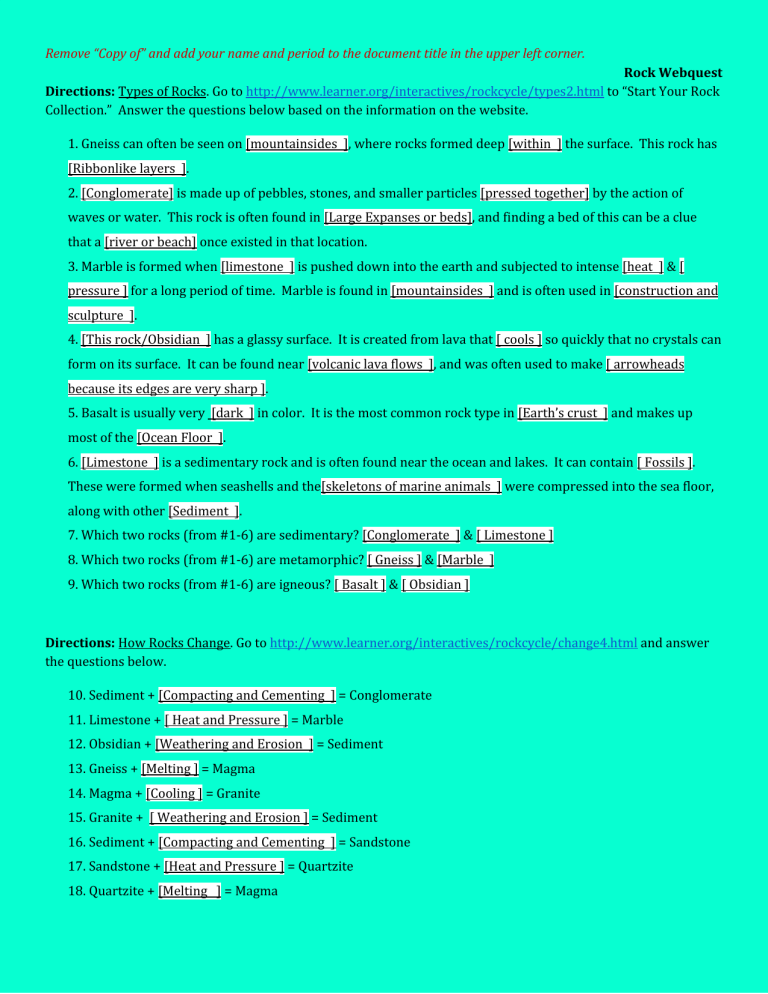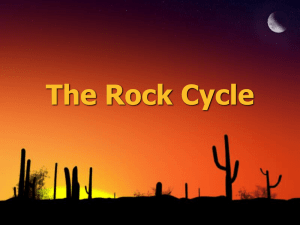
Remove “Copy of” and add your name and period to the document title in the upper left corner. Rock Webquest Directions: Types of Rocks. Go to http://www.learner.org/interactives/rockcycle/types2.html to “Start Your Rock Collection.” Answer the questions below based on the information on the website. 1. Gneiss can often be seen on [mountainsides ], where rocks formed deep [within ] the surface. This rock has [Ribbonlike layers ]. 2. [Conglomerate] is made up of pebbles, stones, and smaller particles [pressed together] by the action of waves or water. This rock is often found in [Large Expanses or beds], and finding a bed of this can be a clue that a [river or beach] once existed in that location. 3. Marble is formed when [limestone ] is pushed down into the earth and subjected to intense [heat ] & [ pressure ] for a long period of time. Marble is found in [mountainsides ] and is often used in [construction and sculpture ]. 4. [This rock/Obsidian ] has a glassy surface. It is created from lava that [ cools ] so quickly that no crystals can form on its surface. It can be found near [volcanic lava flows ], and was often used to make [ arrowheads because its edges are very sharp ]. 5. Basalt is usually very [dark ] in color. It is the most common rock type in [Earth’s crust ] and makes up most of the [Ocean Floor ]. 6. [Limestone ] is a sedimentary rock and is often found near the ocean and lakes. It can contain [ Fossils ]. These were formed when seashells and the[skeletons of marine animals ] were compressed into the sea floor, along with other [Sediment ]. 7. Which two rocks (from #1-6) are sedimentary? [Conglomerate ] & [ Limestone ] 8. Which two rocks (from #1-6) are metamorphic? [ Gneiss ] & [Marble ] 9. Which two rocks (from #1-6) are igneous? [ Basalt ] & [ Obsidian ] Directions: How Rocks Change. Go to http://www.learner.org/interactives/rockcycle/change4.html and answer the questions below. 10. Sediment + [Compacting and Cementing ] = Conglomerate 11. Limestone + [ Heat and Pressure ] = Marble 12. Obsidian + [Weathering and Erosion ] = Sediment 13. Gneiss + [Melting ] = Magma 14. Magma + [Cooling ] = Granite 15. Granite + [ Weathering and Erosion ] = Sediment 16. Sediment + [Compacting and Cementing ] = Sandstone 17. Sandstone + [Heat and Pressure ] = Quartzite 18. Quartzite + [Melting ] = Magma Directions: The Rock Cycle Diagram. Go to http://www.learner.org/interactives/rockcycle/diagram2.html and answer the questions below. Then, using the diagram below, fill in the missing rock cycle steps. 19. When rocks are affected by weathering and erosion, they change into [Sediment ]. 20. When sediment is compacted and cemented, it changes into [Sedimentary Rock ]. 21. When heat and pressure are applied to a sedimentary rock, it changes into [Metamorphic Rock ]. 22. When melting of a metamorphic rock occurs, it changes into [Magma ]. 23. When magma is cooled, it changes into [Igneous Rock ]. 24. [Sedimentary Rock ]Refer to the picture below! 25. [Metamorphic Rock ]Refer to the picture below! 26. [ Magma ]Refer to the picture below! 27. [Igneous Rock ]Refer to the picture below! 28. [Sediment ]Refer to the picture below! Directions: Test Your Skills. Go to http://www.lear ner.org/interactives/rockcycle/testskills.html and enter your name. Answer the fifteen questions, then click “See Your Results.” Take a screenshot (on Chromebook, ctrl + shift + Switch Screens button) of your results and insert the image below (Insert + Image...).

